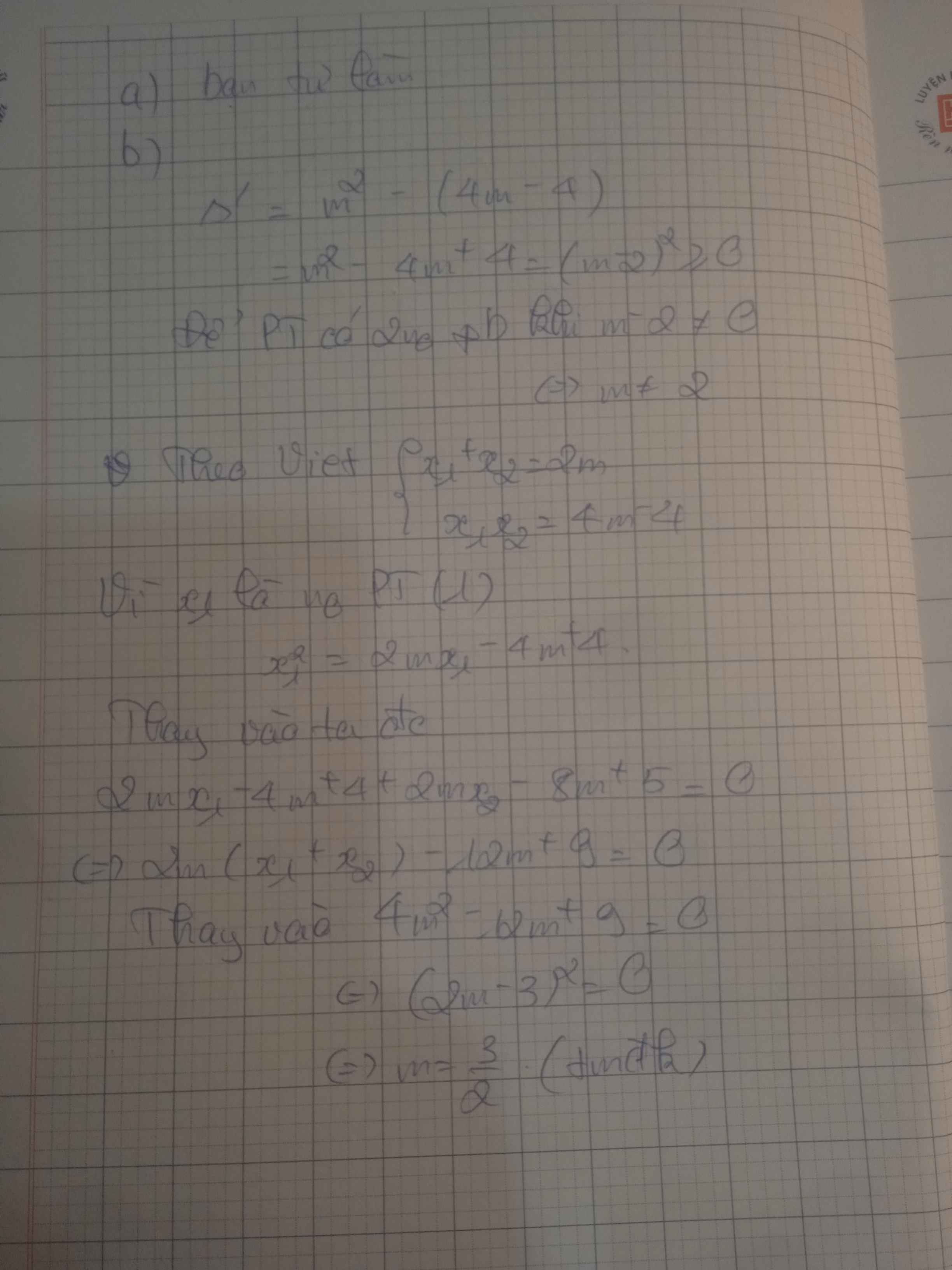Hãy nhập câu hỏi của bạn vào đây, nếu là tài khoản VIP, bạn sẽ được ưu tiên trả lời.

a, \(\Delta=m^2-4\left(-4\right)=m^2+16\)> 0
Vậy pt luôn có 2 nghiệm pb
b, Theo Vi et \(\left\{{}\begin{matrix}x_1+x_2=m\\x_1x_2=-4\end{matrix}\right.\)
Ta có \(\left(x_1+x_2\right)^2-2x_1x_2=5\)
Thay vào ta được \(m^2-2\left(-4\right)=5\Leftrightarrow m^2+3=0\left(voli\right)\)
Bạn ơi, mình có thể hỏi câu c được không ạ? Nếu không được thì không sao, mình cảm ơn câu trả lời của bạn ạ ^-^ chúc bạn một ngày tốt lành nhé.

\(\Delta=a^2-4\left(b+2\right)>0\)
Theo hệ thức Viet: \(\left\{{}\begin{matrix}x_1+x_2=-a\\x_1x_2=b+2\end{matrix}\right.\) (1)
\(\left\{{}\begin{matrix}x_1-x_2=4\\\left(x_1-x_2\right)^3+3x_1x_2\left(x_1-x_2\right)=28\end{matrix}\right.\)
\(\Leftrightarrow\left\{{}\begin{matrix}x_1-x_2=4\\64+12x_1x_2=28\end{matrix}\right.\)
\(\Leftrightarrow\left\{{}\begin{matrix}x_1-x_2=4\\x_1x_2=-3\end{matrix}\right.\)
\(\Rightarrow\left\{{}\begin{matrix}x_1=3\\x_2=-1\end{matrix}\right.\) hoặc \(\left\{{}\begin{matrix}x_1=1\\x_2=-3\end{matrix}\right.\)
Thế vào (1) để tìm a; b

a: Thay m=-5 vào (1), ta được:
\(x^2+2\left(-5+1\right)x-5-4=0\)
\(\Leftrightarrow x^2-8x-9=0\)
=>(x-9)(x+1)=0
=>x=9 hoặc x=-1
b: \(\text{Δ}=\left(2m+2\right)^2-4\left(m-4\right)=4m^2+8m+4-4m+16=4m^2+4m+20>0\)
Do đó: Phương trình luôn có hai nghiệm phân biệt
\(\dfrac{x_1}{x_2}+\dfrac{x_2}{x_1}=-3\)
\(\Leftrightarrow x_1^2+x_2^2=-3x_1x_2\)
\(\Leftrightarrow\left(x_1+x_2\right)^2+x_1x_2=0\)
\(\Leftrightarrow\left(2m+2\right)^2+m-4=0\)
\(\Leftrightarrow4m^2+9m=0\)
=>m(4m+9)=0
=>m=0 hoặc m=-9/4

a) Điều kiện để phương trình có hai nghiệm trái dấu là :
\(\left\{{}\begin{matrix}m\ne0\\\Delta phẩy>0\\x_1.x_2< 0\end{matrix}\right.\)
\(\Leftrightarrow\left\{{}\begin{matrix}m\ne0\\m^2+4m+4-m^2+3m>0\\\dfrac{m-3}{m}< 0\end{matrix}\right.\)
\(\Rightarrow0< m< 3\)
b) Để phương trình có 2 nghiệm phân biệt thì : \(\Delta\) phẩy > 0
\(\Rightarrow m< 4\)
Ta có : \(\dfrac{1}{x_1^2}+\dfrac{1}{x_2^2}=2\)
\(\Leftrightarrow x_1^2+x_2^2=2x_1^2.x_2^2\)
\(\Leftrightarrow\left(x_1+x_2\right)^2-2x_1.x_2=2x_1^2.x_2^2\)
Theo Vi-ét ta có : \(x_1+x_2=\dfrac{-2\left(m-2\right)}{m};x_1.x_2=\dfrac{m-3}{m}\)
\(\Rightarrow\dfrac{4\left(m-2\right)^2}{m^2}-2.\dfrac{m-3}{m}=2.\dfrac{\left(m-3\right)^2}{m^2}\)
\(\Leftrightarrow m=1\left(tm\right)\)
Vậy...........
a) \(mx^2+2\left(m-2\right)x+m-3=0\left(1\right)\)
Để \(\left(1\right)\) có hai nghiệm trái dấu \(\Leftrightarrow\left\{{}\begin{matrix}\Delta'=\left(m-2\right)^2-m\left(m-3\right)>0\\\dfrac{m-3}{m}< 0\end{matrix}\right.\)
\(\Leftrightarrow\left\{{}\begin{matrix}m^2-4m+4-m^2-3m>0\\0< m< 3\end{matrix}\right.\) \(\Leftrightarrow\left\{{}\begin{matrix}7m+4>0\\0< m< 3\end{matrix}\right.\)
\(\Leftrightarrow\left\{{}\begin{matrix}m>-\dfrac{4}{7}\\0< m< 3\end{matrix}\right.\) \(\Leftrightarrow0< m< 3\)
b) \(\dfrac{1}{x^2_1}+\dfrac{1}{x^2_2}=2\Leftrightarrow\dfrac{x^2_1+x_2^2}{x^2_1.x^2_2}=2\) \(\Leftrightarrow\dfrac{\left(x_1+x_2\right)^2-4x_1.x_2}{x^2_1.x^2_2}=2\)
\(\Leftrightarrow\left(\dfrac{x_1+x_2}{x_1.x_2}\right)^2-\dfrac{4}{x_1.x_2}=2\)
\(\Leftrightarrow\left(\dfrac{\dfrac{2\left(2-m\right)}{m}}{\dfrac{m-3}{m}}\right)^2-\dfrac{4}{\dfrac{m-3}{m}}=2\)
\(\Leftrightarrow\left(\dfrac{2\left(2-m\right)}{m-3}\right)^2-\dfrac{4m}{m-3}=2\)
\(\Leftrightarrow4\left(2-m\right)^2-4m\left(m-3\right)=2.\left(m-3\right)^2\)
\(\Leftrightarrow4\left(4-4m+m^2\right)-4m^2+12=2.\left(m^2-6m+9\right)\)
\(\Leftrightarrow16-16m+4m^2-4m^2+12=2m^2-12m+18\)
\(\Leftrightarrow2m^2+4m-10=0\)
\(\Leftrightarrow m^2+2m-5=0\)
\(\Leftrightarrow\left[{}\begin{matrix}m=-1+\sqrt[]{6}\\m=-1-\sqrt[]{6}\end{matrix}\right.\) \(\Leftrightarrow m=-1+\sqrt[]{6}\left(\Delta>0\Rightarrow m>-\dfrac{4}{7}\right)\)

Ta có \(ac=-m^2-2< 0\) ; \(\forall m\) nên pt đã cho luôn có 2 nghiệm trái dấu
Mà \(x_1< x_2\Rightarrow\left\{{}\begin{matrix}x_1< 0\\x_2>0\end{matrix}\right.\) \(\Rightarrow\left\{{}\begin{matrix}\left|x_1\right|=-x_1\\\left|x_2\right|=x_2\end{matrix}\right.\)
\(\Rightarrow2\left|x_1\right|-\left|x_2\right|=4\Leftrightarrow-2x_1-x_2=4\)
Kết hợp với hệ thức Viet: \(x_1+x_2=-m+1\)
\(\Rightarrow\left\{{}\begin{matrix}-2x_1-x_2=4\\x_1+x_2=-m+1\end{matrix}\right.\) \(\Rightarrow\left\{{}\begin{matrix}-x_1=-m+5\\x_1+x_2=-m+1\end{matrix}\right.\)
\(\Rightarrow\left\{{}\begin{matrix}x_1=m-5\\x_2=-2m+6\end{matrix}\right.\)
Thay vào \(x_1x_2=-m^2-2\)
\(\Rightarrow\left(m-5\right)\left(-2m+6\right)=-m^2-2\)
\(\Leftrightarrow m^2-16m+28=0\Rightarrow\left[{}\begin{matrix}m=2\\m=14\end{matrix}\right.\)


\(x^2+\left(4m+1\right)x+2\left(m-4\right)=0\)
\(\Delta=\left(4m+1\right)^2-4\cdot1\cdot2\left(m-4\right)=16m^2+8m+1-8m+32=16m^2+33\ge33>0\forall m\)
\(\Leftrightarrow\left\{{}\begin{matrix}x_1=\dfrac{-\left(4m+1\right)+\sqrt{16m^2+33}}{2}\\x_2=\dfrac{-\left(4m+1\right)-\sqrt{16m^2+33}}{2}\end{matrix}\right.\)
Mà: \(x_2-x_1=17\)
\(\Leftrightarrow\dfrac{-\left(4m+1\right)-\sqrt{16m^2+33}}{2}-\dfrac{-\left(4m+1\right)+\sqrt{16m^2+33}}{2}=17\)
\(\Leftrightarrow\dfrac{-\left(4m+1\right)-\sqrt{16m^2+33}+\left(4m+1\right)-\sqrt{16m^2+33}}{2}=17\)
\(\Leftrightarrow\dfrac{-2\sqrt{16m^2+33}}{2}=17\)
\(\Leftrightarrow\sqrt{16m^2+33}=-17< 0\)
Vậy không có m thỏa mãn